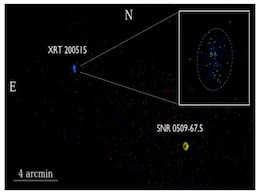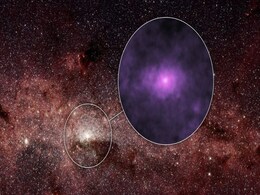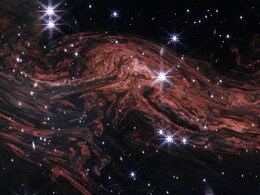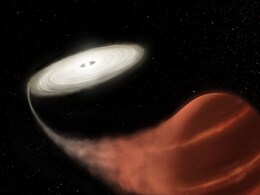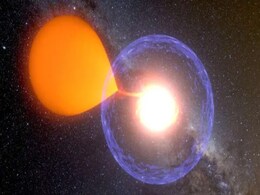Star Explosion
- All
- News
- Videos
- Web Stories
-

"When You Focus Only On...": Pakistan Star Faheem Ashraf's Explosive Take After Big Loss vs New Zealand
- Thursday April 3, 2025
- NDTV Sports Desk
Pakistan cricket team all-rounder Faheem Ashraf did not mince his words in the post-match press conference following a heavy defeat against New Zealand in the second ODI encounter.
-
 sports.ndtv.com
sports.ndtv.com
-

A Star Is Set To Explode Today, Will Be Visible To Naked Eye
- Thursday March 27, 2025
- Science | Edited by NDTV News Desk
A faint star in a constellation visible from the Northern Hemisphere after dark may explode on Thursday in what's going to be a once in 80 years occurrence.
-
 www.ndtv.com
www.ndtv.com
-

A Star Could Explode In Once-In-80-Year Event Next Week. What To Know
- Friday March 21, 2025
- World News | Edited by NDTV News Desk
T Coronae Borealis, a faint star in the Northern Crown constellation, is on the verge of exploding in a nova, which occurs only once every 80 years, researchers have said.
-
 www.ndtv.com
www.ndtv.com
-

Supernova Remnants Found in Oceanic Samples, Scientists Look to Moon
- Wednesday March 26, 2025
- Written by Gadgets 360 Staff
Scientists have identified supernova debris in deep-sea sediments, including a rare plutonium isotope linked to a kilonova. Researchers believe a neutron star collision occurred nearly 10 million years ago, scattering radioactive material across space. To validate this theory, they plan to analyze lunar soil, which remains undisturbed by Earth's ge...
-
 www.gadgets360.com
www.gadgets360.com
-

Unusual X-ray Flash in Large Magellanic Cloud Puzzles Astronomers
- Tuesday February 25, 2025
- Written by Gadgets 360 Staff
A brief yet intense X-ray flash, XRT 200515, was detected in NASA's Chandra telescope data from 2000. The signal, originating from the Large Magellanic Cloud, has left scientists debating its cause. Possible explanations include a neutron star pulling in gas from a companion star or a powerful flare from a distant magnetar. Researchers also specula...
-
 www.gadgets360.com
www.gadgets360.com
-

Vera C. Rubin Observatory to Detect Millions of Exploding Stars
- Wednesday January 29, 2025
- Written by Gadgets 360 Staff
The Vera C. Rubin Observatory, set to begin its 10-year Legacy Survey of Space and Time (LSST) later this year, will track millions of Type Ia supernovae to advance our understanding of dark energy. These supernovae, resulting from white dwarf stars in binary systems, will be studied in detail to provide crucial data on the universe’s acceleratin...
-
 www.gadgets360.com
www.gadgets360.com
-

Early Supernovas Could Have Created Water in the Universe, Paving the Way for Life 100 Million Years Post-Big Bang
- Friday January 24, 2025
- Written by Gadgets 360 Staff
A recent study suggests that supernova explosions, triggered by the death of early stars, could have created significant amounts of water just 100 million years after the Big Bang. Simulations of these early, massive stars show that their explosive deaths may have resulted in the formation of water molecules within the dense hydrogen and oxygen clo...
-
 www.gadgets360.com
www.gadgets360.com
-

Zombie Star’s Mysterious Spiky Filaments Baffle Astronomers in New Discovery
- Thursday January 23, 2025
- Written by Gadgets 360 Staff
A zombie star remnant, Pa 30, located 6,500 light-years from Earth, is surrounded by spiky filaments that have baffled astronomers. These filaments, observed for centuries, continue to puzzle scientists, as their formation and long-term stability remain unclear. The star's explosion in 1181 was initially noted by skywatchers, but its remnant struct...
-
 www.gadgets360.com
www.gadgets360.com
-

James Webb Space Telescope Unveils Hidden Interstellar Wonders of Supernova Cassiopeia A
- Friday January 17, 2025
- Written by Gadgets 360 Staff
The James Webb Space Telescope has provided a rare glimpse into the remnants of a centuries-old supernova in Cassiopeia A. Using infrared technology, the telescope captured a light echo caused by a massive star’s explosion, unveiling new insights into the interstellar medium and its magnetic structures. This breakthrough discovery offers valuable...
-
 www.gadgets360.com
www.gadgets360.com
-

James Webb Space Telescope Detects Supernova From 11.4 Billion Years Ago
- Friday January 17, 2025
- Written by Gadgets 360 Staff
Astronomers using the James Webb Space Telescope (JWST) have identified AT 2023adsv, a supernova that occurred 11.4 billion years ago. This stellar explosion, from a star 20 times the size of the Sun, offers a glimpse into the early universe's unique stellar evolution. Part of the JWST Advanced Deep Extragalactic Survey, the event highlights how th...
-
 www.gadgets360.com
www.gadgets360.com
-

White Dwarf’s Unexplainable Rapid Spin Finally Decoded by Scientists
- Tuesday January 14, 2025
- Written by Gadgets 360 Staff
The white dwarf star RX J0648.0–4418, 1,700 light-years away, spins at a rapid pace of 13 seconds per rotation. Part of a binary system with a helium-burning hot subdwarf star, it continues to shrink while accreting material. This rare and short-lived system provides a unique view into stellar evolution. Approaching the Chandrasekhar limit, RX J0...
-
 www.gadgets360.com
www.gadgets360.com
-

Supernova Remnant G278.94+1.35 is Closer to Earth, Claims New Study
- Friday January 10, 2025
- Written by Gadgets 360 Staff
Astronomers discovered that the supernova remnant G278.94+1.35 is located just 3,300 light years away, much closer than previously believed. Initially thought to span over 500 light years, it is now estimated to measure around 189 by 182 light years. Named "Diprotodon" after Australia’s extinct giant marsupial, this structure remains in an expand...
-
 www.gadgets360.com
www.gadgets360.com
-

Astronomers Spot New Cosmic Explosions 100 Times Brighter Than the Sun
- Wednesday December 25, 2024
- Written by Gadgets 360 Staff
Astronomers have discovered a new class of cosmic explosions, known as 'millinovas,' which are 100 times brighter than the Sun. These events, first identified in 2023, were observed in the Large and Small Magellanic Clouds, two satellite galaxies of the Milky Way. The millinovas are thought to occur when white dwarfs feed off a companion star, prod...
-
 www.gadgets360.com
www.gadgets360.com
-

Scientists Develop New Approach to Capture Gravitational Wave Memory from Supernovae
- Wednesday December 18, 2024
- Written by Gadgets 360 Staff
A study published in Physical Review Letters highlights new methods to detect the gravitational wave memory effect, a unique phenomenon predicted by Einstein's general relativity. Core-collapse supernovae (massive stellar explosions) generate these low-frequency gravitational waves, offering a rare glimpse into stellar interiors. Despite their weak...
-
 www.gadgets360.com
www.gadgets360.com
-

"When You Focus Only On...": Pakistan Star Faheem Ashraf's Explosive Take After Big Loss vs New Zealand
- Thursday April 3, 2025
- NDTV Sports Desk
Pakistan cricket team all-rounder Faheem Ashraf did not mince his words in the post-match press conference following a heavy defeat against New Zealand in the second ODI encounter.
-
 sports.ndtv.com
sports.ndtv.com
-

A Star Is Set To Explode Today, Will Be Visible To Naked Eye
- Thursday March 27, 2025
- Science | Edited by NDTV News Desk
A faint star in a constellation visible from the Northern Hemisphere after dark may explode on Thursday in what's going to be a once in 80 years occurrence.
-
 www.ndtv.com
www.ndtv.com
-

A Star Could Explode In Once-In-80-Year Event Next Week. What To Know
- Friday March 21, 2025
- World News | Edited by NDTV News Desk
T Coronae Borealis, a faint star in the Northern Crown constellation, is on the verge of exploding in a nova, which occurs only once every 80 years, researchers have said.
-
 www.ndtv.com
www.ndtv.com
-

Supernova Remnants Found in Oceanic Samples, Scientists Look to Moon
- Wednesday March 26, 2025
- Written by Gadgets 360 Staff
Scientists have identified supernova debris in deep-sea sediments, including a rare plutonium isotope linked to a kilonova. Researchers believe a neutron star collision occurred nearly 10 million years ago, scattering radioactive material across space. To validate this theory, they plan to analyze lunar soil, which remains undisturbed by Earth's ge...
-
 www.gadgets360.com
www.gadgets360.com
-

Unusual X-ray Flash in Large Magellanic Cloud Puzzles Astronomers
- Tuesday February 25, 2025
- Written by Gadgets 360 Staff
A brief yet intense X-ray flash, XRT 200515, was detected in NASA's Chandra telescope data from 2000. The signal, originating from the Large Magellanic Cloud, has left scientists debating its cause. Possible explanations include a neutron star pulling in gas from a companion star or a powerful flare from a distant magnetar. Researchers also specula...
-
 www.gadgets360.com
www.gadgets360.com
-

Vera C. Rubin Observatory to Detect Millions of Exploding Stars
- Wednesday January 29, 2025
- Written by Gadgets 360 Staff
The Vera C. Rubin Observatory, set to begin its 10-year Legacy Survey of Space and Time (LSST) later this year, will track millions of Type Ia supernovae to advance our understanding of dark energy. These supernovae, resulting from white dwarf stars in binary systems, will be studied in detail to provide crucial data on the universe’s acceleratin...
-
 www.gadgets360.com
www.gadgets360.com
-

Early Supernovas Could Have Created Water in the Universe, Paving the Way for Life 100 Million Years Post-Big Bang
- Friday January 24, 2025
- Written by Gadgets 360 Staff
A recent study suggests that supernova explosions, triggered by the death of early stars, could have created significant amounts of water just 100 million years after the Big Bang. Simulations of these early, massive stars show that their explosive deaths may have resulted in the formation of water molecules within the dense hydrogen and oxygen clo...
-
 www.gadgets360.com
www.gadgets360.com
-

Zombie Star’s Mysterious Spiky Filaments Baffle Astronomers in New Discovery
- Thursday January 23, 2025
- Written by Gadgets 360 Staff
A zombie star remnant, Pa 30, located 6,500 light-years from Earth, is surrounded by spiky filaments that have baffled astronomers. These filaments, observed for centuries, continue to puzzle scientists, as their formation and long-term stability remain unclear. The star's explosion in 1181 was initially noted by skywatchers, but its remnant struct...
-
 www.gadgets360.com
www.gadgets360.com
-

James Webb Space Telescope Unveils Hidden Interstellar Wonders of Supernova Cassiopeia A
- Friday January 17, 2025
- Written by Gadgets 360 Staff
The James Webb Space Telescope has provided a rare glimpse into the remnants of a centuries-old supernova in Cassiopeia A. Using infrared technology, the telescope captured a light echo caused by a massive star’s explosion, unveiling new insights into the interstellar medium and its magnetic structures. This breakthrough discovery offers valuable...
-
 www.gadgets360.com
www.gadgets360.com
-

James Webb Space Telescope Detects Supernova From 11.4 Billion Years Ago
- Friday January 17, 2025
- Written by Gadgets 360 Staff
Astronomers using the James Webb Space Telescope (JWST) have identified AT 2023adsv, a supernova that occurred 11.4 billion years ago. This stellar explosion, from a star 20 times the size of the Sun, offers a glimpse into the early universe's unique stellar evolution. Part of the JWST Advanced Deep Extragalactic Survey, the event highlights how th...
-
 www.gadgets360.com
www.gadgets360.com
-

White Dwarf’s Unexplainable Rapid Spin Finally Decoded by Scientists
- Tuesday January 14, 2025
- Written by Gadgets 360 Staff
The white dwarf star RX J0648.0–4418, 1,700 light-years away, spins at a rapid pace of 13 seconds per rotation. Part of a binary system with a helium-burning hot subdwarf star, it continues to shrink while accreting material. This rare and short-lived system provides a unique view into stellar evolution. Approaching the Chandrasekhar limit, RX J0...
-
 www.gadgets360.com
www.gadgets360.com
-

Supernova Remnant G278.94+1.35 is Closer to Earth, Claims New Study
- Friday January 10, 2025
- Written by Gadgets 360 Staff
Astronomers discovered that the supernova remnant G278.94+1.35 is located just 3,300 light years away, much closer than previously believed. Initially thought to span over 500 light years, it is now estimated to measure around 189 by 182 light years. Named "Diprotodon" after Australia’s extinct giant marsupial, this structure remains in an expand...
-
 www.gadgets360.com
www.gadgets360.com
-

Astronomers Spot New Cosmic Explosions 100 Times Brighter Than the Sun
- Wednesday December 25, 2024
- Written by Gadgets 360 Staff
Astronomers have discovered a new class of cosmic explosions, known as 'millinovas,' which are 100 times brighter than the Sun. These events, first identified in 2023, were observed in the Large and Small Magellanic Clouds, two satellite galaxies of the Milky Way. The millinovas are thought to occur when white dwarfs feed off a companion star, prod...
-
 www.gadgets360.com
www.gadgets360.com
-

Scientists Develop New Approach to Capture Gravitational Wave Memory from Supernovae
- Wednesday December 18, 2024
- Written by Gadgets 360 Staff
A study published in Physical Review Letters highlights new methods to detect the gravitational wave memory effect, a unique phenomenon predicted by Einstein's general relativity. Core-collapse supernovae (massive stellar explosions) generate these low-frequency gravitational waves, offering a rare glimpse into stellar interiors. Despite their weak...
-
 www.gadgets360.com
www.gadgets360.com





